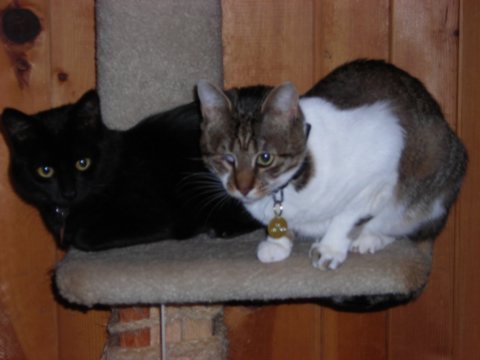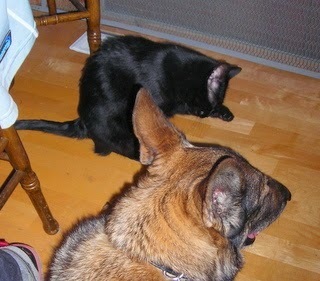Deborah J. Ross's Blog, page 129
October 13, 2014
[rant] Ebola: Why We Need Research Funding
 It's no surprise that folks who think the government should not spend money on anything have targeted such agencies as the National Institutes of Health. After all, the private sector has created the world's best health care, right? (sarcasm glyph) But public health is about a whole lot more than decent sanitation to prevent typhoid or antibiotics to treat bacterial infections. It's about continuing research into prevention -- vaccinations -- and treatment of diseases we don't face in our ordinary lives. Like Ebola, once viewed as a serious but remote disease, something to use for action/thriller movies like Outbreak.
It's no surprise that folks who think the government should not spend money on anything have targeted such agencies as the National Institutes of Health. After all, the private sector has created the world's best health care, right? (sarcasm glyph) But public health is about a whole lot more than decent sanitation to prevent typhoid or antibiotics to treat bacterial infections. It's about continuing research into prevention -- vaccinations -- and treatment of diseases we don't face in our ordinary lives. Like Ebola, once viewed as a serious but remote disease, something to use for action/thriller movies like Outbreak.People who suffer from rare disease know all too well that the private sector -- for profit pharmaceutical companies -- rarely invest their research dollars when there is a small market for a drug or a population of patients who can't afford expensive treatments. Ebola had both strikes against it, plus it happened to people "over there" -- black people, at that. We are all one world, and if compassion doesn't inspire us to address diseases like this with the same fierce dedication as those closer to home, than the ease of transmission across oceans and continents should. "Over there" can be our own backyards in a matter of days. We have a much more robust health care system than do the African nations where Ebola deaths are mounting, but we as communities are just as vulnerable. Here, as there, those who care for the sick are not only most critical in stopping the spread of the disease but are the most vulnerable in terms of becoming its next victims.
What if we as a nation, with all our scientific and medical knowledge, backed by the financial resources of our government -- the way we collectively fund such things -- had continued our search for effective treatments and vaccines? What if we had been able to ship those treatments to Africa when the current Ebola outbreak started? What if every health care worker -- there and here -- who might come into contact with an Ebola patient were vaccinated? How many lives would have already been saved?
Dr. Francis Collins, the head of the National Institutes of Health, said that a decade of stagnant spending has "slowed down" research on all items, including vaccinations for infectious diseases. As a result, he said, the international community has been left playing catch-up on a potentially avoidable humanitarian catastrophe.
"NIH has been working on Ebola vaccines since 2001. It's not like we suddenly woke up and thought, 'Oh my gosh, we should have something ready here,'" Collins told The Huffington Post on Friday. "Frankly, if we had not gone through our 10-year slide in research support, we probably would have had a vaccine in time for this that would've gone through clinical trials and would have been ready."
It's not just the production of a vaccine that has been hampered by money shortfalls. Collins also said that some therapeutics to fight Ebola "were on a slower track than would've been ideal, or that would have happened if we had been on a stable research support trajectory."
"We would have been a year or two ahead of where we are, which would have made all the difference," he said.
Test tub design by Heatherawalls, public domain.

Published on October 13, 2014 12:11
October 8, 2014
Convolution: What makes a good con from an author’s point of view?
 For the last few years, I have rarely attended a convention where I couldn’t commute from home, and they are few, so I was delighted to invited to attend Convolution, a fairly new convention, held at the Hyatt Regency near the San Francisco airport. It was a bit of a drive, but Dave Trowbridge, my lovely spouse, was invited to be a guest, too, and that meant help for the long, late trudge home over twisty mountain roads. For both of us, the convention was an enjoyable, stimulating, and worthwhile endeavor.
For the last few years, I have rarely attended a convention where I couldn’t commute from home, and they are few, so I was delighted to invited to attend Convolution, a fairly new convention, held at the Hyatt Regency near the San Francisco airport. It was a bit of a drive, but Dave Trowbridge, my lovely spouse, was invited to be a guest, too, and that meant help for the long, late trudge home over twisty mountain roads. For both of us, the convention was an enjoyable, stimulating, and worthwhile endeavor. The first thing both of us noticed was the quality of the programming: interesting topics over a wide range of interests. Every event (panels, autographing, reading) that I was included on was something I wanted to be on. The logistics were supportive, too: when I commute, I often face the challenge that the programming folks do not listen when I ask to have my panels grouped together. These folks paid heed, and gave me a wonderful lineup of events. The panels were scheduled every 2 hours, with half an hour for break or wending one’s way along the loooong periphery of each floor.
Registration for guest panelists was smooth and uncomplicated, despite the fact we got there early on Friday afternoon, when chaos typically reigns over convention organization. The Green Room – often a place I dash into and out of because of the loud monologs by a few folks who treat it as their private preserve – was a welcoming place, in no small way due to the warmth and friendliness of the volunteers staffing it.
As a result of having many panels at the same time and the remoteness of the locations, many events were sparsely attended. (Not all, as Dave told me that one of his panels – Religion in SF – was packed.) At first, I found this a bit disappointing, until I wandered into the GoH klatch (informal discussion) and found myself in a room with 4 other people and Tanya Huff, so I have decided it did have its compensations! A few downsides: There were a number of errors in room locations for various events; some appeared to be scheduled in two places at once with no signage as to which was the correct location. The hotel itself was suboptimal. Few spaces created natural meeting places or “community centers” for the convention. Instead, it felt as we were rattling around in a much larger, mundane place. Many of the panels and other events were in conference rooms located along room corridors. This exacerbated the problem of confusing or inaccurate locations.
The hotel restaurant seemed ill-prepared to serve hungry convention-goers, particularly on Friday night. Then the restaurant was closed and only a few tables afforded dining in the bar area. Our party of 5 was told to wait until one of these limited tables opened up, until we asked to speak with a manager. The food, although good, was quite pricey, even by hotel standards. Most other convention hotels offer lower-priced fast-food items as an alternative to elegant, leisurely dining. Parking was expensive, even with the discount, which is only to be expected for an airport hotel.
My scheduling began Friday afternoon with a panel on Classics of SF with Dave, moderator Brad Lyau, and Artist GoH Jeff Sturgeon. Instead of listing the same old Golden Age repertoire, we dived into a lively discussion of what makes a classic, where do we draw the boundaries of science fiction, what were our gateways to the genre, what works should every literate person be familiar with, and what works might be retrospectively added. Brad brought his academic expertise, particularly in the area of international science fiction, for added perspective. And the rest of us were brilliant.
Next up was “The UnPanel,” an event Dave and I began a few years back. It’s a facilitated listening workshop that turns the notion of a panel inside out. Everyone gets a chance to speak without interruption on a topic chosen by the facilitators after learning how to really listen. Because the group was small, each person got ample uninterrupted time to explore their experience of the first book they fell in love with.
I had the delightful experience of sharing a readingslot with Helen Springer, Setsu Uzume, and Juliette Wade. The selections reflected the diversity of our field – dramatic, humorous, fantastical, tragic, romantic, and combinations of all of them. I wanted to run out and buy works by them all!
Then came our dinner adventure, as described above, with Book View Café members and allies. Dave and I drove home (he drove, I slept), fell into bed, then got up and did it all over again.
I began Saturday morning with the Book View Café panel, with Maya Kaathryn Bohnhoff, Amy Sterling Casil, Madeleine Robins, Dave, and me, which turned into a sort of impromptu BVC meeting, since Kit and Howard Kerr were in the audience as well as the panel. One non BVC audience member was a customer, and we pelted her with questions about her experience buying books from us. Next time, we really should rope in more of our book-buying audience!
My friend Juliette Wade and I overlapped autographing sessions, so we hung out together, talking shop. The table was outside the dealers room, always a good idea.
My last panel was one I’d been looking forward to: Handling Rejection in Writing. I moderated fellow panelists Gail Carriger, Juliette Wade, Jon Del Arroz, and Matthew Marovich. Actually, moderating was unnecessary with such an articulate group. We told funny stories, heart-breaking stories, considered the fine art of rejectomancy, and offered support and encouragement to a member of the audience who was struggling to break in with a first sale.
Following that, I snuck into Tanya Huff’s klatch for an hour, enjoying her spin tales of Martin guitars, life in the country, and many other things. Then a group of friends braved the one nearby restaurant, rather than the overpriced if quite good hotel restaurant food (where the prices were low, but the food quality was even lower), a nice ending to my stint. The convention continued for another day, and I wish I had been able to sit in on a few of the many panels that interested me. For a closer hotel, I might have come back.
I’ll return to Convolution next year and hope you’ll check it out, too. Hopefully, some of the hotel problems will be resolved, but the programming and great conversations will continue.
The painting is by Giuseppe de Gobbis (fl. Venice 1772–1783).

Published on October 08, 2014 01:00
October 1, 2014
[link] Art Holcomb on Steps Toward Becoming a Professional Writer
 I knew Art Holcomb decades ago -- gosh, have we been around that long? -- and always respected his insight into writing and publishing. He's a guest blogger over at Larry Brooks's "Storyfix" and has some interesting things to say. He doesn't address how to write, but rather the equally important question of what attitudes and habits comprise a professional attitude.
I knew Art Holcomb decades ago -- gosh, have we been around that long? -- and always respected his insight into writing and publishing. He's a guest blogger over at Larry Brooks's "Storyfix" and has some interesting things to say. He doesn't address how to write, but rather the equally important question of what attitudes and habits comprise a professional attitude. My favorite is Don't Wait For Perfect. Perfect is the enemy of done. And it's also toxic to the creative space so many of us need -- the self-confidence to try new things, but the insecurity to look critically at what we've done. Being a writer (for me, anyway) is a high-wire act, holding that paradox. Perfectionism slams me into paralysis. I have to be willing to be incredibly imperfect in order to take the risks to be great.

Published on October 01, 2014 12:24
September 21, 2014
Convolution Schedule
I'll be a guest panelist at Convolution, Hyatt Regency Burlingame, September 26 and 27.
Friday 2-4 pm The Classics of SF:There is so much to read already with the new stuff, so how do you advise a new reader about SF's great heritage?
Friday 4-5. The Unpanel. A facilitated listening workshop that turns the panel inside out. Everyone gets a chance to speak without interruption on a topic chosen by the facilitators after learning how to really listen.
We've offered this event at several other conventions, with great appreciation from participants. Usually we ask, "Talk about a book that inspired you" or some other topic just about everyone has something to say about. What makes this event different from the usual panels is that every person has uninterrupted time, and everyone gets to listen carefully and deeply to every other person.
Friday 8-10 pm. Reading (from Lambda Literary Finalist novel Collaborators).
I'll have copies to sell, too.
Saturday 10-12 am. Book View Cafe. Members of the cooperative publisher talk about their work, their art and what exactly a cooperative publisher is, anyway.
Saturday 3-4 pm. Autographing.
Saturday 4-6 pm. Handling Rejection in Writing. Sometimes your skin just isn't that thick. How to cope with a chorus of "No" on the path to a "Yes!"
I'm moderating this one, which means it will be fantastic!
Friday 2-4 pm The Classics of SF:There is so much to read already with the new stuff, so how do you advise a new reader about SF's great heritage?
Friday 4-5. The Unpanel. A facilitated listening workshop that turns the panel inside out. Everyone gets a chance to speak without interruption on a topic chosen by the facilitators after learning how to really listen.
We've offered this event at several other conventions, with great appreciation from participants. Usually we ask, "Talk about a book that inspired you" or some other topic just about everyone has something to say about. What makes this event different from the usual panels is that every person has uninterrupted time, and everyone gets to listen carefully and deeply to every other person.
Friday 8-10 pm. Reading (from Lambda Literary Finalist novel Collaborators).
I'll have copies to sell, too.
Saturday 10-12 am. Book View Cafe. Members of the cooperative publisher talk about their work, their art and what exactly a cooperative publisher is, anyway.
Saturday 3-4 pm. Autographing.
Saturday 4-6 pm. Handling Rejection in Writing. Sometimes your skin just isn't that thick. How to cope with a chorus of "No" on the path to a "Yes!"
I'm moderating this one, which means it will be fantastic!

Published on September 21, 2014 15:49
September 19, 2014
The Writing Life: Re-Entry
I've been away from blogging due to a family medical emergency, so I thought it fitting to return with
 Tissot, The Dreamer (1871)an essay on "getting back into writing."
Tissot, The Dreamer (1871)an essay on "getting back into writing."Maybe some writers have uninterrupted careers. I don’t know any, and I certainly don’t qualify. Sometimes it seems that my writing life has been one uninterrupted series of interruptions. If it’s not one thing, it’s not another. Then I have to wrestle not just with getting back up to speed on the project du jour and making up for lost time, but wrestling with guilt, regret, and self-doubt.
Guilt because I shouldhave been able to keep focused, keep writing, No Matter What. Isn’t that what a professional writer does? If “those other” successful writers can churn out 2500 words a day, come rain come shine come conventions come weddings, then I should be able to. Right?
Regret because of all the moments spent checking my email or playing Scrabble online or anything else but writing. If only I’d resisted the temptation, I’d be well ahead of the game when an interruption happens.
Self-doubt because the present interruption will only prove – publicly and conclusively – that I don’t have what it takes. Everything else I’ve written (12 traditionally published novels, somewhere around 60 published short stories, award nominations, etc.) was smoke and mirrors. Hand-waving, nothing more. And now everyone will find out. It’s called the imposter syndrome, and I am far from alone in experiencing it. My version is that because I’ve been interrupted and I’m having trouble getting back on track, I never will. That’s all she wrote. Literally.
Before I run the risk of turning into a blubbering mass of self-pity, I do have some defense against the aforementioned demons.
Knowing I’m not alone in having difficulty diving back into my writing routine is helpful, too. This is especially true when I think of writers I admire and the similar challenges they have faced. (That’s also one reason I’m writing this blog, passing it on!)
One of my favorite co-panelists at conventions, Maya Kaathryn Bohnhoff, talks about “writer’s gap.” That’s her way of looking at “writer’s block.” She says you know where it is you want to go (in the story), you just don’t know how you’re going to get there (yet). This is such an encouraging concept, I have applied it to the difficulty of getting re-started after an interruption. I don’t have to know exactly which strategies and micro-strategies are going to work for me this time around. All I have to do is have faith that something will work, that I will be resourceful in coming up with that something, and this too shall pass.
Strategies? Did I say I have strategies for dealing with interruptions?
Strategies sound so formal, like roadmaps etched in granite or super-sure-fire remedies for Doldrums-Of-the-Muse. Speaking only for myself, I have never found a magic bullet or a guaranteed cure. What I have done is flail about until something works. Maybe the thing I thought helped actually made no difference, it was simply time for me to move on. Maybe I got so frustrated with struggling and getting nowhere that it was easier to sit down and write. But maybe each thing I tried brought me that much closer to success in a sort of cumulative, synergetic effect.
Maybe each time I tried something, I became more determined to break through the stalemate.
Here are some things that have helped me:
Admit that I’m stuck and remind myself that it’s something that happens to great writers.Using blog posts, emails, paper letters, or other “ordinary” writing as a warmup.Calling or emailing a fellow writer, one whose sympathy and discretion I trust.“Getting a running start:” reading back over the last thing I worked on to get my head back into the story. Then: adding one sentence. One paragraph. One page. Setting achievable daily goals (see above.) I can almost always slog through one sentence. If I do enough “just one sentences,” I sometimes find myself back in the zone.Start something new, often something utterly frivolous and self-indulgent. Indulge in my literary guilty pleasures.Type out a chapter of a book I adore.Read aloud. Sing the words.Listen to music from movies I love. Movie music is especially inspiring because it has narration, just like written words do, and that makes it easier for me to visualize scenes. Romantic pieces like Rimsky-Korsakov’s Scheherazade would well, too.Take a long walk where I won’t be overheard and say dialog aloud.Draw portraits of my characters. Chart genealogies. Draw maps or plot flow charts.Buy a new journal to keep writing notes in.Do things that re-charge my creative batteries: play, get out in nature, listen to or make music, talk to folks I love, visit museums, play with my pets, dance, visit the ocean or the redwoods…Make sure I’m ready to resume writing. If I’m not, what do I need?
What works for you?

Published on September 19, 2014 01:00
September 2, 2014
[rant] One Space Or Two Between Sentences?
 Apparently, the b/a/t/t/l/e discussion over whether to use one space or two between sentences r/a/g/e/s/o/n continues. Since I have not yet expressed my opinion on the subject, here it is:
Apparently, the b/a/t/t/l/e discussion over whether to use one space or two between sentences r/a/g/e/s/o/n continues. Since I have not yet expressed my opinion on the subject, here it is:You have got to be kidding me, right? Of all the things you could worry about in writing—characters, plot, theme and metatheme, moral center, rising and falling tension, use of language -- you’re obsessed with this?
Once upon a time, when typesetters used single-letter type or operated linotype machines with “hot lead” type, such things as two spaces made sense. Anything that made the typesetter’s job easier made sense. Editors were used to seeing those double spaces after a final period and a single space looked “wrong” and “sloppy” and – heavens! – amateurish, because it was not the norm.
Word processors have changed all that. It’s trivial to do a global search-and-replace two spaces for one. Your editor can, with a couple of clicks, make your manuscript look however she wants. (As an editor, I do this quite a lot and I don’t find it in the least annoying.)
What matters and what has always mattered is not however many spaces you put between sentences. It’s what’s in those sentences and how they fit together to create a story.
The thing is, folks get all worked up about trivialities when they're trying to avoid grappling with the harder, deeper issues. No editor is going to reject an otherwise splendid story because it has the "wrong" number of spaces. Save your passion for what really counts.
Here endeth Deborah’s rant on the subject of double spaces between sentences.

Published on September 02, 2014 09:05
August 29, 2014
GUEST BLOG: Juliette Wade on "Gatekeepers - you're one, too"
 There are always gatekeepers.
There are always gatekeepers.I think when we writers most commonly use the term we're thinking of editors, because editors are he most famous. We think of the magazine slushpiles and those assigned to read them, whether they be designated first readers or head editors. We think also, of course, of the agents and editors in the novel-publishing world. Gatekeepers are the ones who get to say to you,
"Alas..."
or to put it less gracefully,
"No."
Here's the thing, though. The editors and agents aren't the only gatekeepers here. Every one of us who participates in this enterprise is a gatekeeper. It's just that the job of gatekeeping without an official title is far more complex, and more likely to go unnoticed.
Say I'm online and I get approached by someone I don't know, asking to connect or even to have a live hangout with me. How do I know that person is for real, and not some sort of spammer/scammer?
Or...
Say I'm at a convention and someone wants to come up and talk to me about my writing, or their writing, or writing, or science fiction and fantasy in general. And I have somewhere to go, or I feel uncomfortable, or I've been deluged by fans (not that this happens to me!) and have had enough, etc. etc. I say no or back out of the conversation. There are plenty of perfectly legitimate reasons to do this. Some of them have to do with mental bandwidth and exhaustion rather than anything else.
However, this is also where inclusiveness succeeds or fails.
Let me tell you about an experience I had early on in my writing career. I found my way to the local convention because I had started writing, and absolutely loved it, and figured that was a way to meet people in this business (guess what? It was a great one).
At my first visit, I had a three-month-old baby and was just trying to figure out which end was up, and I approached an author after a panel and asked how to get involved, and he very kindly directed me to apply to the convention's writer's workshop. It was a super-brief interaction, but just what I needed. So I went off and a year later showed back up with a story for the writer's workshop, joined the workshop and really enjoyed it... At that point, when I approached the same author to thank him and attempt to have a conversation, he didn't want to talk to me.
This is a hard one, of course. Why should he feel obligated to talk to me? Nobody is obligated to talk to anyone, are they? People have demands on their time. The better known they are, the more likely they are to be deluged with people. They might just be having a bad day. It's not all about me in this world! But the thing that bothered me was that after several consecutive years of attempting to approach him, I showed up with a copy of Analog with my story in it, and his attitude changed instantly. Suddenly he was back to being willing to have a conversation.
That's gatekeeping. Every time we are agreeing or not agreeing to have a conversation, we could be opening a gate or shutting one for someone who needs it. It's a tough responsibility - and involves tough decisions. It would be so easy to lose every moment of our time to people who won't be able to have constructive interactions with us. We have to protect that time, or we can't function as professionals.
So we are always looking for reasons to say no.
Legitimate reasons.
I'll get back to that word "legitimate" in a second.
First off, what exactly is it that says to us at any given point, "This person can't be serious" or "This person is a waste of my time"?
I come out of academia, and in that context, the best way to be taken seriously on the most basic level is to engage with the texts. Of course it depends on whom you're dealing with, but if you can come in having read something, and not just say "I read this" but express an opinion that refers to a particular part of a scientific argument, or a contentious quote, etc. then you are more likely to be taken seriously (this is obviously not foolproof!).
When I approach an author whom I want to interact with as a fellow author and not simply as a fan, I make sure to have read something and thought through an opinion about something very specific. Worldbuilding, most often, since that's my geeky thing. "I liked what you did in X book when you created Y in Z way" is something I like to be able to say. It's sort of a statement of good faith - not foolproof, but at least has a better chance of receiving attention because it's my way of saying I care.
It's important to realize the person just may not have time for you at that moment. And that's okay. They don't owe you, just like you wouldn't want to feel like you owed anyone else.
On the other hand, so many people have helped me that I always feel inspired to some degree to help people out. This is why I find my way to workshops, which are structurally designed to give me a forum for interacting with people and discovering their work. That makes it much easier than just chatting in a hall!
There's something else going on here, though, that comes back to the question of legitimate reasons to say no.
This is a place where bias creeps in. Right there, in that split second when you're turning around to see someone and decide whether to interact with them. When you're looking for a reason why you need to be off to that lunch you have, or why you are too tired to deal with anyone right now, etc. etc. Something about the person can make you say no without you fully making the connection as to why. These are little tiny moments. They pass by us so quickly, but they can be terribly important.
And they are also the places where we can make a big difference for inclusiveness. If we try to think consciously. If we give it a second or two, a word or two of encouragement.
I won't claim this is supposed to be easy. Everybody has a different balance of introversion and extroversion, a different threshold of safety - and maintaining that safety is vitally important. But I also think it's important for people to realize that we are all gatekeepers. We are all constantly re-creating the inclusive or exclusive environment of our social milieu, whenever we say yes or no.
It's something to think about.

Published on August 29, 2014 01:00
August 22, 2014
The Tajji Diaries: Alarm Clock

Dogs, like many other animals, are Creatures of Schedule. They seem to feel most secure when recurring events are predictable – the sun comes up, monkeys get up, we go walkies, then breakfast, then nap, then playtime…and so forth. They love rituals, like the one Dave has created for putting on the harness. It’s a version of Keepaway, with great romps through the living room, corridors, and open dining area. Her body language says it’s great fun, and she stands willingly when it’s all over. Interestingly, Tajji understands that this is a game to be played only with Daddy Monkey. Mommy Monkey is all business when it comes to gearing up, hence the harness is donned not in the living (Keepaway) area but in the mudroom.
To everything there is a season…
A time to pounce on cats, a time to be rubbed against,A time to nap, a time to romp,A time to cuddle on the monkeys’ bed, a time when doggies are not allowed on the bed…A time to be lazily retired, and a time to impose order on the household.
Now that Tajji has settled into her new family, she feels it is incumbent upon her as the resident dog to impose some degree of order upon her monkeys. We noticed very early on that if either of us closed the door behind us and it did not latch, Tajji would very shortly poke her nose in, ascertain we were okay, and then withdraw. She was keeping an eye on us! (This was a little disconcerting at first in the bathroom.)
Monkeys and doggie do not always agree on what constitutes a proper daily schedule. Dave gets up quite early, but especially when I’ve had a rough night, I’ll sleep in, hauling myself out of bed between 7:30 and 8:00 am.
Tajji has other ideas.
She has determined that the proper time for me to wake up is 7:15 am, and she’s remarkably precise about it. I don’t know what will happen in the winter when it’s barely light at that hour, but so far, she begins her wake-up call within 5 minutes of the appointed time.
First bell: She stands on my side of the bed, panting. If I don’t respond, she pokes me with a wet nose. (So far, no kisses.)Second bell: She hops on the bed with me, usually nicely at my feet, and sighs dramatically.Third bell: I have not yet discovered further escalation. The first two are usually more than enough. I leave it to your imagination.
Dave, considerate spouse that he is, will close the bedroom door so that I can get a bit of extra sleep. The photo shows Tajji and Gayatri expressing their opinion of being prevented from performing their vital wake-up duties. It’s a good thing neither of them has opposable thumbs, don’t you think?

Published on August 22, 2014 02:00
August 20, 2014
And Now A Word From The Cats…
 Shakir and GayatriI’ve been blogging about Tajji, our newly-adopted retired seeing eye dog, all the training we’re doing with her, how she’s recovering from the stress of many years of service. The cats have played no small role in helping her to adjust, and she in turn has provided them with interest and amusement.
Shakir and GayatriI’ve been blogging about Tajji, our newly-adopted retired seeing eye dog, all the training we’re doing with her, how she’s recovering from the stress of many years of service. The cats have played no small role in helping her to adjust, and she in turn has provided them with interest and amusement.“What’s that? Oh, you’ve brought us a dog to play with. She’s very big and very, very furry.”
“Um, this dog is exceptionally rude. She moves too quickly and looks directly at us.”
“Um, this dog is also exceptionally stupid. Sure, she’s finally understood how to greet us politely and that we don’t like big things moving fast in our general direction. But when we tell her we’d like to play, she acts brain-dead. And what’s with her bowing to us? What the heck does that mean?”
“Shakir has finally educated the dog to the point where they can romp, even if the dog does get carried away. He bestows upon the dog the great honor of grooming her, despite getting a mouthful of fur – the dog is incredibly furry! But she seems oblivious of his signals that he’d like her to groom him in return. Gayatri is of the opinion that being slobbered all over does not constitute grooming.”
Both cats have now marked the dog as Theirs by rubbing their jaws along her muzzle or feet. But cats have lives beyond taking care of the dog. They engage in various typically feline behaviors, each having staked out several prime napping areas (that vary according to seasonal sunlight).
Gayatri has turned out to be musical. She’s an extremely vocal cat and will meow loudly under many different circumstances:
“Where have you been? How dare you neglect me for this long?”
“I’m starrrrving!”
“Out! Now!”
"Pick me up! Nooooowwww!"
“I know you want to nap but I want to knead your stomach more.”
“Piano! What is that sound! I must sing with it!”
The last isn’t entirely true. As far as I can tell, Gayatri’s vocalizations bear no relationship in pitch or tempo to the music I’m playing. She seems to be saying, “Female monkey is sitting still. This must be an invitation to curl up on her chest and knead it ferociously. What’s this shelf, conveniently placed so that I can have access to said chest and why is the surface unsteady? What’s that noise – oh, not worthy of my attention. Just noise.”
As you can deduce, Gayatri often comes running (meowing loudly) when I play piano. She regards the keyboard as the perfect intermediate step from the floor to my chest. Unlike other cats, she doesn’t seem to make the association between stepping on the keys and the resulting noise. It makes no difference to her that I happen to be playing those same keys. Attempting to play while a cat is walking across the keyboard, often stepping on exactly the keys I need, is an exercise is futility. My perfectly good piano instantly transforms into one with half its notes unavailable.
The fascinating thing is that Gayatri does not do this with at random. Chopin and Brahms do not summon her, nor do Satie, Bach, Kabalevsky, or Turlough O’Carolan. She comes running when I play “Song of the LonelyMountain” from The Hobbit: An Unexpected Journey. Sometimes I sing it, but not always, and that seems to make no difference. It would be lovely if she wanted to sing with me, but such is not the case. Nor is the song quality of the piece the determining factor, at least I think not. The O’Carolan pieces have the same strong beat and melody lines.
I suspect there is a hidden attraction, like a fantasy pheromone, sensible only to cats. Undoubtedly, if I played the theme from Harry Potter, she would respond. (I’ll save that experiment for the future and report back to you.) My belief is that, being a cat who lives with two writers, one of whom loves Tolkien, the Peter Jackson movies, and who is hard at work at a fantasy novels, Gayatri feels it incumbent upon her as the resident avatar of Bast to show proper appreciation and encouragement.
The cat may have another opinion. They always do.

Published on August 20, 2014 01:00
August 15, 2014
The Tajji Diaries: “Cats and Dogs Living Together…”
 Shakir invites play
Shakir invites playIn recent blog posts, Dave and I have discussed Tajji’s progress in dealing with other dogs. Tajji is our newly (5 months) adopted retired seeing eye dog, a 10 year old German Shepherd female who had major reactivity issues, especially with small dogs. The extraction of a fractured tooth has resolved her chronic pain, and enrollment in a reactive dog class (“Reactive Rover” taught by Sandi Pensinger of Living With Dogs, using only positive techniques, never punishment) has given us all tools to continue progress.
It’s time for an update on Tajji’s adventures in Living With Cats. For the 8 years of her working life, she did not live with cats, although we assume she was exposed to them as part of her early socialization and training. We introduced her to our two dog-savvy cats in stages, beginning with barriers and progressing to escape-places for the cats and lots of human supervision. After some initial confusion on the part of the dog, because cats and dogs interprets many body-language signals in different ways, communication was established and détente soon followed.
The next phase was entirely the doing of Shakir, our black male cat who has a history of being extremely fond of large dogs. He adored our previous German Shepherd Dog, who was too intimidated to let Shakir cuddle with him. Tajji is of a much more phlegmatic temperament than our previous dog, and it wasn’t too long before she would curl up at our feet at the dining table and Shakir would come over, approaching her politely (no direct eye contact, curved path, looking away, soft eyes). A sniff became a rub, and soon he was polishing her feet, her muzzle, and the sides of her head with his jaw. Purring loudly, he’d pass under her head, turn and repeat, and I’m sure the banquet of kitty-butt smells was delightful to the dog.
One of Shakir’s favorite pastimes became chewing on Tajji’s nails. This is fascinating for two reasons. One is that he loves to chew on his own hind claws (never the front ones). The other is that she has hollow nails and is sensitive about her feet. (We’re working on that.) We’ve looked down to see him curled at her feet, his tail draped over her nose.
From time to time, we noticed that Tajjir would rush at Shakir, often at great speed, and we became concerned that if her prey drive were sufficiently engaged, she might injure him. All dogs have some degree of prey drive, and German Shepherd Dogs tend to fall at the higher end, so saying that Tajji has the lowest prey drive of any GSD we’ve known isn’t saying much. For a time, we put up the baby gates across the division between living and dining rooms. Then we noticed that Shakir would duck under the gate, turn around, and with an air of feline insouciance, saunter back under it. In other words, he was inviting her to chase him.
Needless to say, our house is well supplied with places cats can jump up on or crawl or behind that are not dog-accessible. The logical conclusion is that any time either of the cats is running toward or away from the dog, it’s because they choose to.
The cats are fully in control of the situation. The dog only pretends to be.
One way Shakir invites play is to roll over on his back, waving his paws, claws extended. He is extremely careful to retract those claws once someone – human, canine, or feline – engages with him. (Incidentally, he also strongly prefers to be stroked gently, and will enforce that preference.) Tajji does not know quite what to make of this. I think she’d “get” a play bow, but cats don’t do that. Shakir has been rolling over for her, at first on the other side of a set of chair legs, then on the same side, getting ever closer and closer. Once or twice, she’s responded by trying to place her paw on him. This hasn’t worked out all that well, as the touch is way too heavy and rough for him. He flips over and heads for the nearest no-dog zone.
One of these days, one of them will pick a play strategy (other than “Chase”) that the other will understand. Or we’ll find the two of them fast asleep, cuddled against each other.

Published on August 15, 2014 01:00



